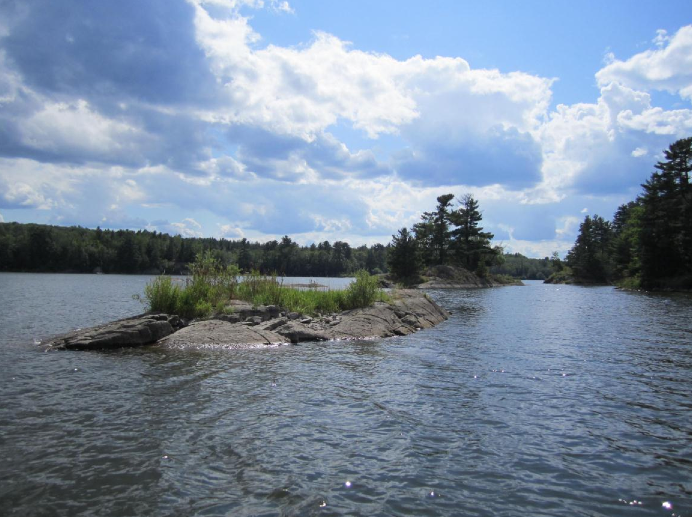By CELESTE BOTT
Capital News Service
LANSING — Deer Lake in Ishpeming, classified as a major international toxic hot spot since 1987, may get a clean bill of health this year after decades of costly cleanup.

Deer Lake in Ishpeming
Credit: Stephanie Swart, Department of Environmental Quality.
Environmental officials and residents of Marquette County are awaiting U.S. State Department action on Michigan’s recommendation to remove the lake from the list of Areas of Concern – AOCs – established by the International Joint Commission, a U.S.-Canadian advisory group.
Deer Lake was designated as an AOC in 1987.
“At this point I do not have any information as to when the U.S. State Department will approve the delisting of the Deer Lake AOC, but hopefully by the end of October this will happen,” said Stephanie Swart, Deer Lake’s area of concern coordinator at the Department of Environmental Quality (DEQ).
DEQ and the U.S. Environmental Protection Agency “will be hosting a celebration up in Ishpeming when we get the word,” Swart said.
The lake was contaminated with mercury from nearby mines. The Ropes Gold and Silver Mine, northwest of Deer Lake, used a mercury amalgamation process to concentrate gold.
Another source was the Cleveland-Cliffs Iron Co. (now Cliffs Natural Resources) ,which disposed of waste containing mercury down laboratory drains that led to Ishpeming’s wastewater treatment plant, according to state regulators.
But most of the mercury in the lake came from Partridge Creek, which Ishpeming diverted in 1970 to flow through the Cliffs Shaft Mine tunnels beneath the city. That kept it from overflowing during storms, but the diverted creek picked up mercury from dynamite blasting caps and eventually transported it into Deer Lake.
The lake was also essentially a sewer lagoon until wastewater treatment plants were built in the 1980s, said Pete Nault, vice-chair of the Deer Lake Public Advisory Council.
Ishpeming had dumped untreated wastewater into Partridge Creek and Carp Creek, which also flow into Deer Lake, Nault said.
When wastewater treatment plants couldn’t filter out phosphate-rich soap powders and laundry detergents, algal blooms appeared in the lake. An improved secondary municipal wastewater treatment plant replaced the city’s three primary treatment plants in 1985, and nutrient-loading to Carp Creek and Deer Lake decreased significantly.
“There were a number of what the Environmental Protection Agency calls beneficial use impairments, or pollution problems, that made Deer Lake an unsafe body of water,” said Nault.
“The sewage brought nitrogen and phosphorus, which caused algal blooms. The fish were unsafe to consume. And there was a survey done looking at the bald eagles and loons in the area that found they couldn’t reproduce,” Nault said.
There are 43 AOCs in the United States and Canada — 26 in the U.S., 12 located in Canada and five shared by both nations.
In the U.S., two have been cleaned up enough to be taken off the list: the Oswego River in New York in 2006 and the Presque Isle Bay on Lake Erie in 2013. In Canada, Collingwood Harbor, Severn Sound and Wheatley Harbor have been delisted.
For an area to be removed from the list, cleanup targets of a Remedial Action Plan must be met. Advisory councils must show monitoring data that proves those targets have been met and maintained, though targets vary in different AOCs.
As Deer Lake improved, the advisory council successfully petitioned for removal of several “beneficial use” impairments.
The International Joint Commission defines such impairments as “a change in the chemical, physical or biological integrity of the Great Lakes system”.
Impairments to the health of birds and animals and problems that contributed to the grow of undesirable algae were both removed in 2011. Restrictions related to eating fish and wildlife \were eased last February.
In a letter earlier this year to the EPA, DEQ Director Dab Wyant credited efforts by state, local and federal governments and the advisory council for controlling the causes of the impairments, “and all three beneficial uses have been restored.”
Nault said mercury contamination was cleaned up enough for delisting when Partridge Creek was diverted from the historic Cliffs Shaft Mine. Officials estimate a quarter of the lake’s mercury contamination had come from Partridge Creek alone.
New stormwater drains and sidewalks were built to accommodate stormwater overflow.
The Partridge Creek diversion wasn’t cheap or quick. It started in 2011 and completed last November. An $8 million grant from the
Great Lakes Restoration Initiative — a federal cleanup effort —and $700,000 from Ishpeming covered the costs.
DEQ’s Swart said that price tag doesn’t take into account local contributions or staff time put in by her department and the Department of Natural Resources (DNR).
There’s hope that taking Deer Lake off the AOC list could boost tourism.
Ishpeming City Manager Mark Slown said in a statement that the Partridge Creek project will improve fish populations and provide additional green space that beautifies the community.
Though the cleanup efforts have led to the Department of Community Health easing some restrictions on eating Deer Lake fish, the DNR has so far maintained that it will remain a catch-and-release lake even if it’s delisted, Swart said.
Celeste Bott writes for Great Lakes Echo.